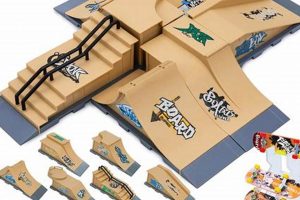Specialized carrying solutions designed for skateboarders facilitate the transport of boards and related gear. These bags typically feature straps or compartments to securely hold a skateboard, along with additional space for items such as helmets, pads, tools, and personal belongings. For instance, a student who skateboards to campus may utilize one to carry their books and laptop alongside their board.
The utilization of such carrying systems offers several advantages. It allows for hands-free mobility, enhancing safety and convenience for skateboarders navigating urban environments. The historical development of these specialized bags reflects the growing popularity of skateboarding as a mode of transportation and recreational activity. These systems protect valuable equipment and ensure the safe transport of essential items.
The following sections will delve into the various types available, key features to consider when selecting a suitable model, and provide guidance on proper usage and maintenance to maximize longevity and functionality.
Selection and Usage Guidance
The following recommendations provide insights into selecting and utilizing specialized carrying systems for skateboards and associated equipment.
Tip 1: Prioritize Durability. Examine the construction materials. Reinforced stitching and abrasion-resistant fabrics such as ballistic nylon enhance longevity, particularly with frequent use. For example, selecting a model with a high denier rating in the fabric indicates increased resistance to tears and punctures.
Tip 2: Assess Carrying Capacity. Determine the required volume based on typical load. Consider the size of the skateboard, protective gear, and personal items. Insufficient capacity leads to discomfort and potential damage. Conversely, an excessively large model adds unnecessary bulk.
Tip 3: Evaluate Strap Configuration. Ensure the shoulder straps are padded and adjustable. A sternum strap distributes weight effectively, reducing strain on the shoulders and back. Models with breathable mesh backing improve ventilation and comfort, especially during warmer conditions.
Tip 4: Verify Skateboard Retention Mechanism. Scrutinize the security and accessibility of the skateboard straps. Straps should be adjustable and capable of securely holding various board sizes. Quick-release buckles facilitate convenient skateboard attachment and removal.
Tip 5: Inspect Compartmentalization. Look for designated compartments for organizing equipment. Separating skate tools, personal items, and electronics prevents damage and facilitates access. A dedicated compartment for a water bottle is also a valuable feature.
Tip 6: Consider Weather Resistance. If frequent exposure to inclement weather is anticipated, opt for models constructed from water-resistant materials or those featuring a rain cover. Protection from moisture safeguards electronics and other sensitive items.
Employing these guidelines optimizes the selection and utilization of skateboard carrying solutions, leading to enhanced convenience, safety, and equipment longevity.
The next section will provide a summary of common issues and maintenance for these specialized bags.
1. Board carrying capacity
Board carrying capacity is a primary determinant of a skateboard carrying system’s utility. It defines the range of skateboard sizes and styles that the system can securely accommodate, influencing the user’s ability to transport their equipment effectively.
- Skateboard Dimensions and Compatibility
Different skateboard types possess varying dimensions. Longboards necessitate larger carrying capacity compared to standard skateboards or cruisers. Incompatible carrying capacity can result in insecure board attachment, increasing the risk of damage to the board or injury to the user.
- Retention System Design
The design of the retention system directly affects board carrying capacity. Adjustable straps, enclosures, or pockets provide versatility in accommodating boards of different widths and lengths. Insufficient adjustability limits the range of compatible skateboards.
- Weight Distribution and Balance
Optimal weight distribution is crucial for comfortable carrying. Board carrying capacity influences the overall weight distribution. Overloading the system beyond its intended capacity compromises balance, leading to strain and discomfort. A well-designed system distributes weight evenly, minimizing strain.
- Impact on Overall Bag Volume
Board carrying capacity directly affects the bag’s total volume. Integrating a skateboard carrying system inherently increases the overall size of the bag. Designers must balance the need for sufficient carrying capacity with maintaining a manageable and ergonomic form factor. A too-large bag is cumbersome. The skateboard straps should not be hindering the user.
Considering these facets ensures that a skateboard carrying system effectively meets the user’s specific needs. Matching board carrying capacity to the intended skateboard type and usage scenario is crucial for a safe and comfortable experience.
2. Compartment Organization
Compartment organization within specialized carrying systems significantly impacts functionality and user experience. The arrangement and design of compartments dictate the efficiency and security with which various items, including skateboards and associated gear, can be stored and accessed.
- Dedicated Skateboard Storage
The presence of a dedicated skateboard compartment, typically featuring straps or a secure sleeve, prevents the board from shifting during transit. This reduces the risk of damage to the board and other contents, while also minimizing potential hazards to the user and surrounding individuals. A poorly secured skateboard can cause imbalance and impede movement.
- Protective Gear Segregation
Separate compartments for protective gear such as helmets, pads, and guards isolate these items from other belongings. This prevents contamination from dirt and debris accumulated during skateboarding activities. A designated compartment also safeguards delicate items, such as electronic devices, from potential damage caused by bulky protective equipment.
- Tool and Accessory Management
Integrated organizational panels or smaller pockets within compartments provide dedicated storage for tools, hardware, and other skateboarding accessories. This facilitates efficient access to these items for on-the-go repairs and adjustments. Proper tool organization prevents damage to bag interiors and ensures tools are readily available when needed.
- Personal Item Separation
Compartment organization enables the segregation of personal items, such as wallets, keys, and mobile phones, from skateboarding equipment. This prevents damage and loss of valuable personal belongings. A designated compartment for personal items improves accessibility and reduces the time required to locate essential items.
Effective compartment organization optimizes the utilization of space within the carrying system. It streamlines the packing and unpacking process while also enhancing the protection of valuable items. The strategic arrangement of compartments directly contributes to the overall convenience and functionality of carrying solutions.
3. Durability Materials
Material selection is paramount in the construction of skateboard carrying systems, directly influencing the product’s lifespan and resistance to the rigors of skateboarding use. The inherent properties of the chosen materials determine the bag’s ability to withstand abrasion, tearing, and environmental factors.
- Abrasion Resistance
Materials used in the high-wear areas of skateboard carrying systems, such as the base and skateboard attachment points, must exhibit substantial abrasion resistance. Fabrics like ballistic nylon or Cordura nylon, characterized by their dense weave and high tensile strength, are commonly employed. For instance, the bottom of the bag, frequently dragged on pavement, requires a material capable of withstanding constant friction. This characteristic directly impacts the bag’s longevity and protects internal contents.
- Tear Strength
The tear strength of a fabric dictates its ability to resist ripping or tearing when subjected to stress. Skateboard carrying systems are often exposed to sharp objects and sudden impacts. Materials with high tear strength, measured in Newtons, are essential for preventing catastrophic failures. Reinforced stitching and seam taping augment tear resistance, particularly at stress points like shoulder strap attachments and zipper junctions.
- Water Resistance
Water-resistant materials shield the contents of the skateboard carrying system from moisture damage. Fabrics treated with a durable water repellent (DWR) coating impede water penetration. Waterproof zippers and sealed seams further enhance water resistance. In regions with frequent precipitation, water resistance is a critical attribute for protecting sensitive items such as electronics and skate tools.
- UV Resistance
Prolonged exposure to ultraviolet (UV) radiation degrades many synthetic materials, leading to discoloration and embrittlement. Skateboard carrying systems used outdoors require UV-resistant fabrics to mitigate these effects. Materials treated with UV inhibitors maintain their structural integrity and aesthetic appearance over extended periods of sun exposure. This is especially important in climates with high UV indexes.
The selection of appropriate materials, considering abrasion resistance, tear strength, water resistance, and UV resistance, is a key factor in the overall performance and durability of skateboard carrying systems. These material characteristics collectively determine the product’s ability to withstand the demands of regular skateboarding activity and environmental exposure.
4. Ergonomic Design
Ergonomic design constitutes a crucial factor in the functionality and user experience of skateboard carrying systems. The correlation between ergonomic considerations and the design of these systems directly impacts user comfort, safety, and long-term physical well-being. Suboptimal ergonomic design can lead to musculoskeletal strain, discomfort, and potential injuries, thereby diminishing the utility of the carrying system.
The ergonomic design of a skateboard carrying system encompasses several key aspects. These include the design and placement of shoulder straps, the inclusion of a sternum strap and hip belt for load distribution, the contouring of the back panel for optimal spinal alignment, and the overall weight distribution of the system. A system with poorly designed shoulder straps may cause localized pressure points, leading to shoulder and neck pain. The absence of a sternum strap or hip belt compromises load distribution, increasing strain on the back and shoulders. Consider a student transporting a skateboard and textbooks. Without adequate ergonomic design, the weight distribution would be uneven, potentially leading to back pain and postural problems. A system with well-padded, adjustable shoulder straps, a sternum strap, and a contoured back panel distributes the load more evenly, reducing strain and promoting a more comfortable carrying experience.
In conclusion, the ergonomic design of skateboard carrying systems directly affects user comfort, safety, and long-term health. Prioritizing ergonomic considerations, such as load distribution, spinal alignment, and pressure point mitigation, is essential for creating systems that are both functional and conducive to user well-being. Manufacturers must focus on ergonomic design principles to optimize user experience. Prioritizing ergonomic design elevates the functionality and usability, resulting in a product that enhances the skateboarding experience.
5. Weather Resistance
The integration of weather resistance into skateboard carrying systems addresses the inherent risks associated with transporting equipment in variable environmental conditions. Moisture, precipitation, and extreme temperatures pose significant threats to the integrity of both the skateboard and personal belongings contained within the bag. Skateboard decks, typically constructed from laminated wood, are susceptible to warping and delamination upon prolonged exposure to moisture. Metallic components, such as bearings and hardware, are prone to corrosion, leading to performance degradation. Personal electronics and other sensitive items can suffer irreversible damage from water ingress. Without adequate weather resistance, the contents of the system are vulnerable to environmental degradation, potentially resulting in equipment failure or data loss.
The implementation of weather-resistant features within skateboard carrying systems provides a critical layer of protection against environmental factors. Water-resistant fabrics, such as those treated with durable water repellent (DWR) coatings, impede the penetration of moisture. Waterproof zippers and sealed seams further enhance the system’s ability to withstand exposure to precipitation. An integrated rain cover offers an additional level of protection in inclement weather. For instance, a student commuting to campus on a skateboard can rely on a weather-resistant carrying system to safeguard their laptop and textbooks from rain. The system is designed to keep moisture out.
In summary, weather resistance is a crucial attribute of skateboard carrying systems. It mitigates the risks associated with environmental exposure, safeguarding equipment and personal belongings from damage. The incorporation of water-resistant materials, waterproof components, and protective features ensures the durability and reliability of the system. This design addresses the need for equipment protection. These protective measures improve the longevity and usability of carrying solutions, enabling skateboarders to transport their equipment with confidence, regardless of weather conditions.
6. Security Features
The incorporation of security features within skateboard carrying systems directly addresses the risks of theft and unauthorized access. These specialized bags, often containing valuable skateboarding equipment, personal belongings, and electronic devices, are susceptible to opportunistic theft, especially in urban environments and public spaces. The absence of adequate security measures increases the vulnerability of these items, potentially resulting in financial loss and inconvenience for the user. For example, a skateboarder leaving their bag unattended at a skatepark while practicing is exposing their belongings to potential theft if the bag lacks appropriate security features. The presence of such features serves as a deterrent to potential thieves and provides a degree of protection against unauthorized access.
Specific security features commonly found in skateboard carrying systems include lockable zippers, hidden compartments, and slash-resistant materials. Lockable zippers allow users to secure the main compartments of the bag with a padlock, preventing unauthorized access to the contents. Hidden compartments provide discreet storage for valuables, making them less susceptible to theft. Slash-resistant materials, such as reinforced nylon or wire mesh, protect the bag’s exterior from being cut open, hindering attempts to steal the contents. The practical application of these features provides users with increased peace of mind and reduces the likelihood of theft, allowing them to focus on their skateboarding activities without constant concern for the security of their belongings. For instance, a student using a carrying system with lockable zippers and a hidden compartment can securely store their laptop and wallet while skateboarding to class, minimizing the risk of theft and disruption.
In summary, security features are a critical component of skateboard carrying systems. They mitigate the risks of theft and unauthorized access. Lockable zippers, hidden compartments, and slash-resistant materials provide tangible protection for valuable belongings. These are significant in enhancing the functionality and peace of mind of the user. Continuous innovation in security technologies is essential to address the evolving tactics of thieves and maintain the effectiveness of these protective measures. Therefore, carrying systems require robust and adaptable security measures to meet these needs.
Frequently Asked Questions About Skate Backpacks
The following section addresses common inquiries regarding specialized carrying systems for skateboards and associated equipment. The information provided aims to clarify misconceptions and provide a comprehensive understanding of these products.
Question 1: What distinguishes a specialized carrying system from a conventional system?
Specialized carrying systems possess unique features designed to accommodate skateboards and related gear. These features typically include board-carrying straps, reinforced construction, and dedicated compartments for protective equipment and tools. Conventional bags lack these attributes, rendering them less suitable for transporting skateboarding equipment.
Question 2: What is the optimal method for cleaning and maintaining a specialized carrying system?
Regular cleaning is essential for preserving the functionality and appearance of a carrying system. Remove loose dirt and debris with a brush or vacuum cleaner. Spot clean stains with a mild detergent and water. Avoid harsh chemicals or abrasive cleaners, which may damage the fabric or components. Allow the bag to air dry completely before storing or using.
Question 3: How does the carrying capacity influence the overall weight distribution and comfort?
Excessive loads compromise weight distribution and ergonomics. Overloading the system leads to increased strain on the shoulders and back. Distributing weight evenly across the shoulders, back, and hips promotes comfort and minimizes the risk of injury. Select a carrying system with sufficient capacity to accommodate the intended load without exceeding its weight limit.
Question 4: What criteria should be considered when evaluating the durability of the materials?
Abrasion resistance, tear strength, and water resistance are critical indicators of material durability. High-denier fabrics, such as ballistic nylon or Cordura, exhibit superior abrasion resistance. Reinforced stitching and seam taping enhance tear strength. Water-resistant coatings or waterproof membranes protect the contents from moisture damage. Assess these factors based on the intended usage environment and frequency of use.
Question 5: What role do security features play in protecting valuables stored within?
Security features, such as lockable zippers, hidden compartments, and slash-resistant materials, deter theft and unauthorized access. Lockable zippers prevent easy access to the main compartments. Hidden compartments conceal valuables from prying eyes. Slash-resistant materials protect the bag from being cut open. These features provide an enhanced level of security, reducing the risk of theft and loss.
Question 6: How does the design of the shoulder straps and back panel affect user comfort?
Padded and adjustable shoulder straps distribute weight evenly and minimize pressure points. A sternum strap and hip belt further enhance load distribution and stability. A contoured back panel promotes proper spinal alignment and ventilation. Ergonomically designed shoulder straps and back panels contribute to user comfort, reducing strain and fatigue during extended periods of wear.
Proper selection, usage, and maintenance of specialized carrying systems contributes to equipment protection and user convenience. Understanding the product attributes leads to informed decision-making and maximizing longevity.
The subsequent sections will explore case studies related to real-world scenarios.
Skate Backpacks
This exploration has underscored the multifaceted nature of skate backpacks, extending beyond mere carrying solutions. Attributes such as board retention, compartmentalization, material durability, ergonomic design, weather resistance, and integrated security features collectively define their utility and value. Consideration of these aspects is paramount in selecting a system that effectively safeguards equipment, enhances user convenience, and promotes safe transport.
The informed application of these insights is essential. Future innovations in materials and design will undoubtedly refine these carrying systems, further optimizing their functionality and durability. Prioritizing informed selection ensures skateboarders are equipped to navigate their environments with both security and efficiency, extending the lifespan of their equipment and enhancing their overall skateboarding experience.







